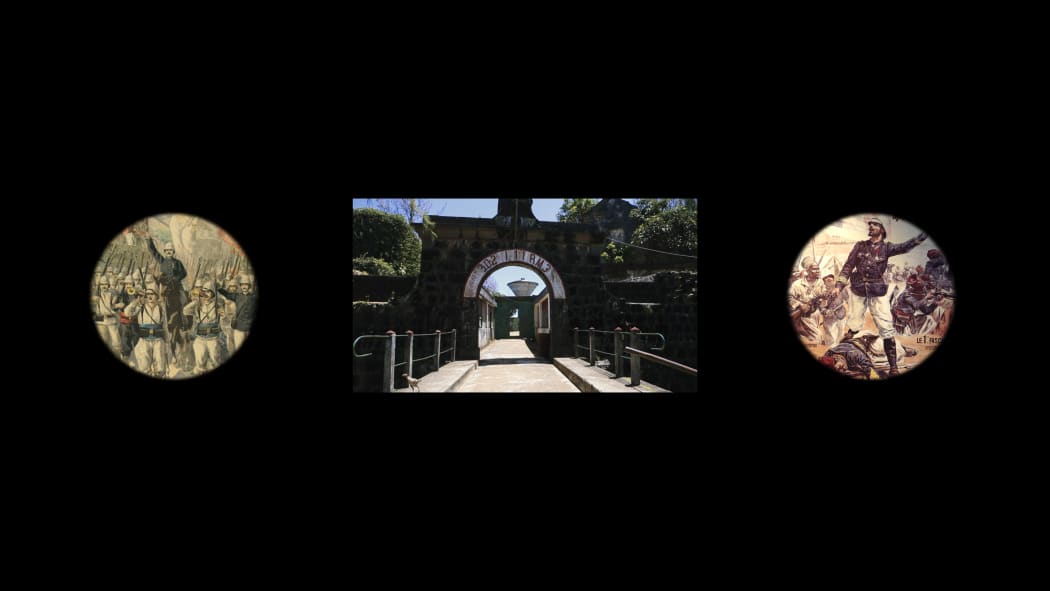
Searching for Libertalia
SHIRAZ BAYJOO, 2019
3 channel video
Commissioned by New Art Exchange
Libertalia was ‘a myth amongst pirates, their holy grail’, Shiraz Bayjoo explains. It was that heady rumour which gave its name to Daniel Defoe’s outlaw kingdom in his 1742 General History of the Pyrates – and the document’s slippery status of faux-chronicle which Bayjoo drew into his 2019 film work Searching for Libertalia.
Defoe imagined Madagascar as Libertalia’s host island, and debate wages still as to the precise blend of truth and fiction which comprised the idyllic settlement. Leveraging Madagascar’s microcosm to shed light on African independence movements, gathering momentum as Europe’s grip on former colonies began to erode in the 20th century, Bayjoo describes Defoe’s Libertalia as ‘a complete creation of European imaginings, of the other, of the island state’. From romantic ideas of an isolated sanctuary for pirates like Defoe’s to the Vichy’s presence in the tropics – tracked in the film’s footage of artillery discarded after the second world war – the island’s story has been written and rewritten at the whims of respective interested parties over centuries. Across fascist narratives of racial hierarchy and the French East India Company’s devious accounts of island slave-trading, Madagascar has been the site of countless outside projections of utopia – and despite that concept’s purportedly universal appeal, it’s hard to think of a more subjective fantasy than perfection.
Addressing its central questions with polyphony, Searching for Libertalia arrives at Madagascar’s long-sought independence in 1960 via three strands of imaginative history. Holding diverse sources in generative tension, Bayjoo’s intervention involves untangling their threads as much as weaving them into cogency. Beyond the ‘legitimate’ archival material from the darkest corners of colonial France’s repositories, for instance, there’s more than a grain of truth in even Searching for Libertalia’s most explicitly fictional ingredients. Merchants (operating outside the economic boundaries of their sovereign states or not as the case may be) did use the mainland’s surrounding islands as sites for stopovers and more besides, and Ile Sainte Marie to the east of Madagascar looks a likely contender for the ‘real’ Libertalia. ‘At its height in the 1700s, [there were] about 1500 pirates based there’, explains Bayjoo.
So far, so feasible. But the trouble with stories like Defoe’s, cobbled together from wishful thinking, vested interests and decidedly warped perspectives, is their soothing promise of simplicity. Bayjoo’s practice, on the other hand, engages Madagascar’s history as anything but straightforward; from one angle, Searching for Libertalia finds its subject in our default and damaging preference for picture-book ease. What happens when a reigning power’s vision is dismantled, and a native agenda finally permitted space to unfurl? Is erasure required for revolution, and is it possible in the first place? And what if one people’s success necessitates the immiseration of another?
‘I wanted to create a pseudo archive that would speak to [Malagasy history] and the rise of African post-colonial independence’, says Bayjoo. What emerges is a set of circumstantial power dynamics which seem stuck on a loop; an historical scratched record. Bayjoo explains Searching for Libertalia’s three-channel form: ‘the idea was that you wouldn’t know from which point in time you were entering the story. Whether it was a part of 20th century history, from the 1700s, or part of this fictional story. It was this idea of a never-ending cycle, the repetition of actions and ideas.’ Ally and other, merchant and pirate. Native and coloniser, African and European; transposing politics to identity, Madagascar’s might seem a palimpsestic story of us-and-them – and is there any older?
Perhaps not, but Bayjoo staunchly resists the impulse to lapse into any such hackneyed mantras. After all, the story of warring supremacies on Madagascar is as predictably unpredictable – and tightly knotted – as one might expect. Colonised by the French in 1894, the island nonetheless repelled European dominion for much longer than comparable places and the Malagasy’s earliest dynamic with Western explorers was not simply one of subjugation. Mercantile relationships were as mutually beneficial as they were brutal, and local trading with pirates opened resources hitherto mutually unmined to each group: ‘these European encounters are not as linear as we might think’, explains the artist. On the contrary, ‘this was very complex political manoeuvring’, from both sides of the tideline.
‘We imagine these [places as] remote islands, but actually they were very interconnected even in the 1600s’, says Bayjoo. And as with any historical account – let alone one with winners, losers and no shortage of skin in the game – our focus on a convenient monolith is as problematic as any lie. In the story of Madagascar’s struggle for independence, reductive narratives about tropical paradises are just as troubling as those which frame colonisers as civilising forces.
‘Madagascar was seen as an unconquerable island at that time’, the artist remarks. ‘It had a complex system of tribal kingdoms, not to mention its remoteness in European minds.’ Much mythmaking about buried treasure and far-flung idylls can be traced back to the Indian Ocean, and Madagascar’s position – both geographically and in the middle of world economic tugs-of-war – produced a plethora of competing cultural sources and signifiers. Some strata were lain with violence, others in symbiosis, and others yet by happenstance. Look, listen: a tiny plot of land and its people beckon, fertile ground for our relentless reliance on zooming out and smoothing over. What better setting for Bayjoo to think through Europe’s accounts of its own colonialism? To grapple with arbitrary archive and authorship, and to tell a story from perspectives other than its victor’s? Here, amidst the knots and bones and rebuilding: the moral of the story, beware the moral of the story. Simplicity, suspicious.
By Emily Watkins
If you enjoyed the article, please consider signing up to ECFA's mailing list to stay up to date with Conversation Piece and more.
